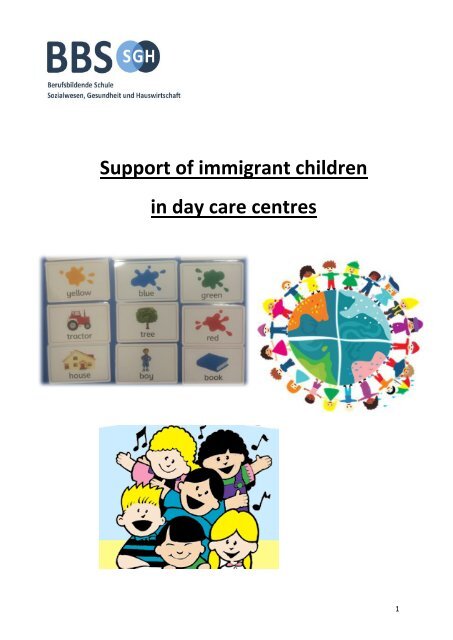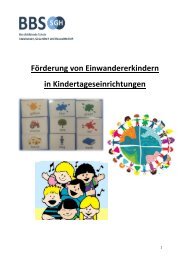Handbucheinträge_ENGLISCH_alle_NEU
You also want an ePaper? Increase the reach of your titles
YUMPU automatically turns print PDFs into web optimized ePapers that Google loves.
Support of immigrant children<br />
in day care centres<br />
1
1) Report by Carmen Wagner | Höhere Berufsfachschule für<br />
Sozialassistenz<br />
Work Placement Institution:<br />
Treetops Nursery, Doyle Gardens, London, NW10 3SQ<br />
Situation 1<br />
Description of the situation<br />
Objects like windows, sinks or welcome-signs in the entrance area are lettered in different<br />
languages and the flag associated with that language. The flags are colorfully colored. Nursery<br />
nurses explain the lettering, if the children are interested, since many children can't read it or do<br />
not know the flags.<br />
Observed support<br />
The children are often interested in the lettering; they ask the nursery nurses what is written there.<br />
The explanation of the lettering and the conversation about it can foster the childrens’ interest in<br />
foreign languages. The children want to learn new words and speak with the other children about<br />
words they have learned. The conversation and the explanation of some words among the children<br />
(who may know them from their own language), can promote the children linguistically and<br />
socially.<br />
Advice for the practical implementation in German day care centres<br />
Also in German nursery schools they can put up letterings with the (colorfully colored) associated<br />
flag on some things like windows or chairs for example. The nursery nurses should explain the<br />
meaning of the different letterings and flags in our country, if the children are interested. Also they<br />
can prepare a talk round about the topic of foreign languages.<br />
Situation 2<br />
Description of the situation<br />
Children's songs, which are known and loved by the children, like "The good morning song", are<br />
sung in different languages. In this way the immigrant children often have often the possibility of<br />
explaining how these songs are sung in their own language.<br />
2
Observed support<br />
The children like to join in. They show interest about learning songs in different languages. Like in<br />
the situation described before, immigrant children have the opportunity to contribute something<br />
and to get recognition from the other children and the nursery nurses, like, in this case, translating<br />
each song, so that they can all learn to sing the song together. It is a great way to linguistically and<br />
socially promote the childrens’ development. Of course, all this happens with the help of the<br />
nursery nurses.<br />
Advice for the practical implementation in German day care centres<br />
Also in German nursery schools we could start to sing well-known and popular children's songs in<br />
different languages. Immigrant children can help to translate the songs.<br />
Situation 3<br />
Description of the situation<br />
In the reading corner of the preschoolers and also in the rooms of the toddlers there are some<br />
foreign-language books, which the children can take anytime they want. These books are read<br />
from time to time in the sitting rounds, if the children propose to read some of these books. If<br />
there are questions, the nursery nurses make also sometimes initiate a talk round about the topic<br />
of the book, the language in which it is written or the country of the language. The immigrant<br />
children can translate the story of the book, if it is written in their own language and if they want<br />
to do it.<br />
Observed support<br />
By reading and listenting to the books, the children learn new words of another language and often<br />
they get interested to learn more about these languages. In doing so, the children be promoted<br />
linguistically. Immigrant children often have the opportunity to translate the story, talk about their<br />
own country or their language. That can again lead to recognition of the immigrant children, to a<br />
great deal of fun when hearing their own language, or only to a feeling of pride because these<br />
children may be the only ones who understood the story. In this way, the children are promoted<br />
socially.<br />
3
Advice for the practical implementation in German day care centres<br />
As well in Germany the nursery schools can keep some foreign language books in its rooms, which<br />
are freely accessible for the children and which will be read on request. Nursery nurses can also,<br />
on request, initiate talk rounds about the book, its story, its language or the country of the<br />
language.<br />
2) Report by Selina Zimmermann | Fachschule für Sozialpädagogik<br />
Work Placement Institution:<br />
Bright Start Day Care, London<br />
Situation 1<br />
Description of the situation<br />
In the reading corner in the grouproom, there is a cardboard c<strong>alle</strong>d „visual sign board“. It has<br />
different cards on it with visual signs the children can use to communicate. Every week the<br />
teachers change the signs and choose one as the “sign of the week“.<br />
Observed support<br />
The teacher sits in the reading corner and shows the children a sign and its meaning. The children<br />
repeat it and learn how to commuinicate with each other. Even if they haven't learned the<br />
language, they are able to tell their needs. Taught are signs for eating, drinking, fire emergency<br />
and so on.<br />
Advice for the practical implementation in German day care cenres<br />
We can create such a cardboard here together with the children. In circletime the signs could be<br />
discussed and taught.<br />
social<br />
Situation 2<br />
Description of the situation<br />
The teachers create a plan for the whole week, based on the childrens’ interests. They write down<br />
4
how the activities will be realized and which vocabulary will be used. There is also a section for<br />
younger children and those with special needs. Here the teachers write down easier activities and<br />
vocabulary.<br />
Observed support<br />
One afternoon we were allowed to help a teacher in the planning process. We developed ideas<br />
about the question of how everybody can participate in the activity.<br />
Advice for the practical implementation in German day care cenres<br />
Every step in projects or activities can be arranged in different degrees of difficulty for the children,<br />
so that everyone can join in. It's part of inclusion to make the sorrounding conditions suitable for<br />
every child.<br />
cultural/social<br />
Situation 3<br />
Description of the situation<br />
In the garden there is a big tree designed by the children. The trunk consists of footprints, the<br />
leaves are made of handprints. All around the tree there are cards with different languages, where<br />
you can see how the different parts of the tree are c<strong>alle</strong>d.<br />
Observed support<br />
The children recognize their own foot- and handprints as one piece of the whole artwork. It's a<br />
symbol for being part of the group. The different countries and languages are all tolerated.<br />
Advice for the practical implementation in German day care cenres<br />
Creative activities are an excellent way to create a community feeling. The artworks make the<br />
children proud of what they reached and they see how teamwork can be. It’s also interesting for<br />
them to learn a few words in another language.<br />
5
3) Report by Sara Partika | Fachschule für Sozialpädagogik<br />
Work Placement Institution:<br />
Little Learners Pre-School, London<br />
Situation 1<br />
Description of the situation<br />
The whole group is sitting in the garden, listening a story the teacher is telling. One little girl is<br />
ignoring them. She wants to play a game in the garden and keeps standing up, because she wants<br />
to walk around. The teacher says, “Sit down and listen to the story!“ But the little girl doesn’t<br />
understand what the teacher says because she speaks another language. Sometimes the girl<br />
understands a little bit but most of the time the girl doesn’t understand what the teacher means.<br />
Observed support<br />
The teacher says to the little girl, “Sit down please“ in English and makes a movement with her<br />
hands. The move shows her to sit down. She doesn’t understand what the teacher means. Then<br />
the teacher uses the language of the girl (Indian) to say, “Sit down“, which is why she now<br />
understands what the teacher asks her to do. At the same time the teacher repeats the sentence<br />
in English.<br />
Advice for the practical implementation in German day care centres<br />
When the children don’t understand what you ask them to do, you can show them what you mean<br />
using gestures. When you speak the native language well you can tell the children what you want<br />
in the native language and then repeat the same sentence in English.<br />
Situation 2<br />
Description of the situation<br />
A new child comes into the group and doesn’t speak English. It is very important that the new child<br />
learns the English language quickly.<br />
Observed support<br />
Every teacher has „visual cues“. These “visual cues“ show pictures of things from everyday life and,<br />
above that, the expression explaining the picture. When the child wants something she/he asks<br />
6
the teacher. The teacher shows the “visual cues“ to the children and she/he can choose one of<br />
them. In order to give the children the possibility to learn the English language the teacher uses<br />
the new word in a full sentence.<br />
Advice for the practical implementation in German day care centres<br />
When you teach a new language to children, it is very important to use full sentences and repeat<br />
the phrase as often as you can. The “visual cues“ help them to learn the language easier and faster.<br />
The children see the pictures and understand what the teacher means because she/he knows what<br />
the picture stands for.<br />
Situation 3<br />
Description of the situation<br />
A new child comes in the group and speaks a different language. The teacher must help the<br />
children to learn the English language.<br />
Observed support<br />
A new child is joining the group and is sitting in the building corner. The teacher is sitting next to<br />
him /her, speakin English with him/her. The teacher has a red car in his/her hand and shows it to<br />
him/her. Then the teacher names the object using just two words, namely “red car“.<br />
Advice for the practical implementation in German day care centres<br />
Children should learn easy words at the begining. The teacher should use only two expressions for<br />
the objects. It is important that the children can see the objects in order for them to make it easier<br />
to understand.<br />
7
4) Report by Sari-Veren Öholm | Fachschule für Sozialpädagogik<br />
Work Placement Institution:<br />
Bright Start Day Care, London<br />
Description of the situation<br />
The information board in the day care centre (for parents AND children) shows different<br />
descriptions of different kinds of words (like water (engl.)- wasser (german)- apa (romanian)).<br />
If the children have difficulties understanding a word the teacher said, they have the opportunity<br />
to go to the board and look it up again.<br />
Observed support<br />
With checking up the words on the board again the children get the chance to build up their self<br />
esteem with improving their language skills on their own. They don't need the help from the<br />
teacher directly because they are much more independent with learning and discovering their<br />
interests.<br />
Hints for the practical implementation in German day care centres<br />
The teachers have the opportunity to print out parent letters in the languages they need to<br />
communicate in the way they need to with the parents from different countries. The letters<br />
sometimes get handed directly to the parents or hung up on the information board (it depends<br />
what the matter of the topic or situation is). Also the new words (on the information board) give<br />
the parents an input to learn and improve their language skills as well.<br />
5) Report by Maria Weber | Fachschule für Sozialpädagogik<br />
Work Placement Institution:<br />
Bluebell Montessori, London<br />
sprachlich<br />
Situation 1<br />
Description of the situation<br />
In the company there is a three-year-old girl. She speaks only Rumanian. Her mom, who works in<br />
this company, speaks only Rumanian, too. She can understand some things but she can’t speak<br />
8
English very well. The little girl is very interested in the English language. She would like to<br />
understand it. When someone speaks English with her she repeats it. The little girl show us with<br />
her finger when she would like something and says, “that“. Naturally, the children use their body<br />
language to express what they need or like.<br />
Observed support<br />
In many cases it’s the teacher who most strikingly influences the children’s process of learning<br />
English. The teacher talks to the children in English only and does not use their mother tongue.<br />
When a child points to a book with its finger, the teacher says, “This is a book, do you like it?“ The<br />
teacher naturally asks in English and avoids the mother tongue (our boss in this case speaks<br />
Rumanian as well, but nevertheless she speaks only English with the little girl). The teacher also<br />
speaks in complete sentences instead of single words.<br />
Hints for the practical implementation in German day care centres<br />
In Germany they mostly handle it the same way.<br />
Situation 2<br />
linguistic social cultural<br />
Description of the situation<br />
Many children who are not yet proficient in English imitate a lot of things in different situations.<br />
The most of time they imitate their friends. They learns better and faster from their friends or<br />
other children when they play. For example, when the teacher says, “Sit down please!” and a<br />
child who understand the language sits down, then the child who doesn’t understand it imitates<br />
it. The child can link the words and the action.<br />
Observed support<br />
Playing together, singing and dancing promotes the community<br />
feeling and a playful encounter with the new language. In the nursery,<br />
they sing and dance a lot. Most of the time they dance and sing on the<br />
cultural carpet. On this carpet you can see different children. They<br />
look different in terms of skin color, which can be white, black or<br />
Asian, and/or the face shape is different. The songs they sing often deal with everyday situations.<br />
9
According to the approach of Maria Montessori, it is important that little children learn a language<br />
with stories, games, songs and rhymes. This method is helpful for learning the vocabulary and<br />
speaking with fun.<br />
Hints for the practical implementation in German day care centres<br />
In most nursery schools they don’t dance much with children. We cannot generalize this though,<br />
because there are some nursery schools where this is quite common. However, in my internships<br />
I have never experienced nursery nurses who danced with the children.<br />
Situation 3<br />
linguistic<br />
cultural<br />
Description of the situation<br />
What I also discovered in the nursery school were cards with different pictures on it, for example<br />
of a dog, a doll or a red dab of paint. A lot of children in this nursery school are from different<br />
countries, such as Poland, Bulgaria, China , India , England , Romania and Lithuania. With the help<br />
of these cards they can learn colors, objects or motives. But all in all they need the help of a<br />
teacher.<br />
Observed support<br />
In a silent minute the teacher works with only one child. The teacher puts the cards on the table.<br />
The child can now tell the teacher which of the objects it can already name, for example a cat.<br />
Subsequently the teacher takes the cards the child could not label and tells him what is on it. The<br />
child repeats it. With the help of the pictures on the cards the children learn what kind of thing<br />
they should imagine when I say, “This is a dog”. The children understand what a “dog” is.<br />
Hints for the practical implementation in German day care centres<br />
I’ve never seen cards like this in German nursery schools before. I really liked these cards,<br />
because the children can link the word with the picture and this is a simple way to learn the<br />
language.<br />
10





